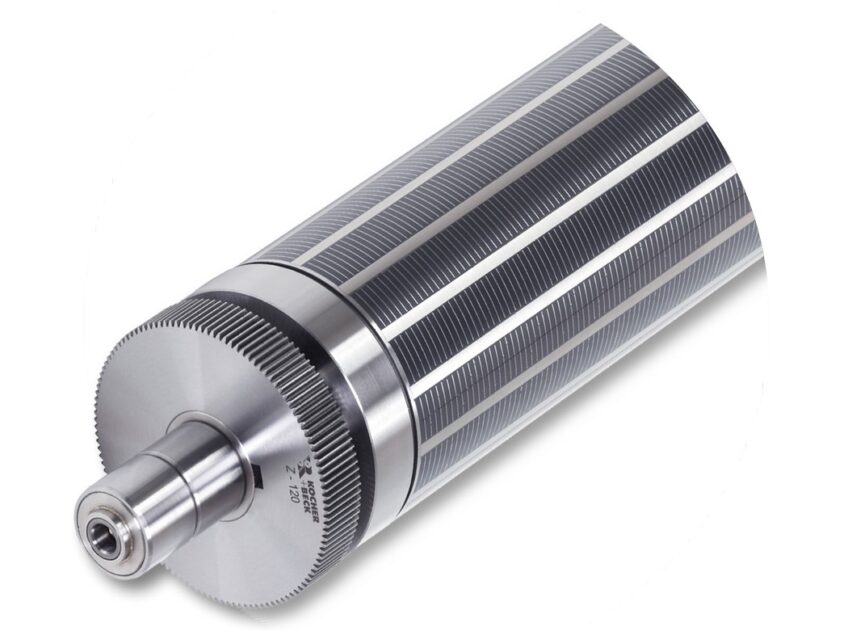Label & Narrow Web recently had the luxury of sitting down with David Morris, president of Kocher + Beck USA, to discuss the latest enhancements to the GapMaster. Morris, who has spent nearly 30 years with the company, was promoted to president in 2014.
Morris has served in multiple roles throughout the company, including managing director of Kocher + Beck UK and senior executive vice president at Kocher + Beck USA.
What is the science behind Kocher + Beck’s GapMaster, and how can label converters benefit?
On conventional diecutting stations, whether equipped with solid tooling or magnetic cylinders and flexible dies, the cutting depth is determined by the difference in dimension of the bearers and the height of the cutting blade in relation to the anvil surface. Traditionally, the only adjustment that is possible is by the increase or decrease of pressure, to try to compensate for a cutter that is not cutting deep enough or a cutter that is cutting too deep. Such adjustments in pressure can also affect the stability of the cutting process, which is essential for consistent diecutting results.
It is not uncommon to see high levels of pressure applied to try to adjust for badly worn cutters or for different backing materials, but in truth the application of such high levels of pressure only reduces the life of the bearings and bearer surfaces, and has little to no effect on the result of the diecut. If a die is cutting into the liner, there is no way to increase the air gap; the only solution is to stop the press and install a new cutter.
The GapMaster system eliminates the disadvantages of the fixed system by the introduction of an adjustable anvil cylinder. Eccentric controlled bearers allow the adjustment of the free running cylinder body by a total of +/- 0.1mm, effectively moving the anvil surface closer or further away from the die. The GapMaster enables adjustment to one or both sides of the air gap between the cutting cylinder and the anvil in steps of 0.8 µm. This allows the air gap to be adjusted up and down to accommodate a wide range of backing materials without changing the cutter, and will also compensate for die wear and extend the life of the die.
Even more importantly, it gives the press operator a high level of control on the diecutting results while at the same time being able to apply the ideal amount of pressure to achieve diecutting stability. A split and scaled setting control is mounted on the operator side the unit to give easy access to adjustments which can be made either with the press stationary or in full production.
How has the GapMaster evolved from its initial release?
When the GapMaster was first released, it was only available for a handful of press makes and models in narrow web formats and required a manual lubrication process. As converters and press manufactures saw the advantages of the system and demand grew, the system was developed for a wide variety of press types, models and widths. An automatic lubrication version was introduced, followed by the GapMaster IC and the latest addition: the GapMaster MF.
How does the GapMaster IC differ from the GapMaster?
The original GapMaster design required an adjustment shaft to pass through the operator side of the frame in order to be secured on the drive side frame, with the adjustment knob assembly bolted directly to the operator side of the cutting station frame. The function and design of the GapMaster IC anvil cylinder and its bearings are identical to those of the GapMaster, however, the adjustment system and knob are integrated directly into the bearing block assemblies, eliminating the need for the separate adjustment shaft and the need to therefore modify the cutting station frame. This makes each GapMaster IC independent from the cutting station, and it is supplied fully calibrated and with its own lifting bar. This eliminates the need for final calibration during initial installation or re-installation. This also allows the GapMaster IC to be used in multiple cutting units of the same design. Furthermore, it can be used for underside cutting.
How has this product been engineered to help the press operator?
The use of pressure alone to control the cutting process gives the press operator a limited window of control. If a cutter is cutting too deep and the press operator reduces the pressure, they can quickly get to a point where they are no longer applying enough pressure to have stability over the cutter, giving random and inconsistent diecutting results. If a cutter is not cutting deep enough, applying more pressure only allows for a limited amount of adjustment, and the excess pressure can quickly lead to damage of the bearings and bearer surfaces.
The GapMaster from Kocher + Beck gives the operator full control of the diecutting process. The operator still applies pressure to gain stability over the cutter but then easily and independently uses the GapMaster to precisely control the depth of cut.
The use of the GapMaster system allows for:
- Reduced waste and rejections due to heavy diecutting
- Increased die life
- Reduced wear of the magnetic cylinder
- Reduced load on die station/press
- Reduction in the number of press stoppages, increasing uptime/productivity
- Adjustment for fluctuations in substrate thickness
- Parallel and one side adjustment of cutting depth
How does the GapMaster complement your other product portfolios? Kocher + Beck is proud to be a world leader in innovation and a complete systems provider. Our focus is to provide our customers with the highest-quality products and solutions, enabling them to operate in an efficient and productive manner. This applies to all our products, whether we are talking about our high precision flexible dies, tight tolerance magnetic cylinders, TecScreen screen printing material, quick change diecutting stations or our GapMaster adjustable anvil system.

